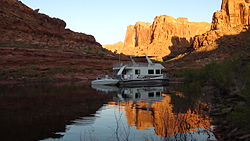Glen Canyon National Recreation Area
| Glen Canyon National Recreation Area | |
|---|---|
IUCN category V (protected landscape/seascape) | |
| Lua error in Module:Location_map at line 526: Unable to find the specified location map definition: "Module:Location map/data/USA relief" does not exist. | |
| Location | Kane, San Juan, Garfield, and Wayne counties, Utah & Coconino County, Arizona, USA |
| Nearest city | Page, Arizona, Bullfrog, Utah |
| Area | 1,254,117 acres (507,523 ha)[1] |
| Established | October 27, 1972 |
| Visitors | 2,270,817 (in 2011)[2] |
| Governing body | National Park Service, Bureau of Reclamation |

Glen Canyon National Recreation Area (shortened to Glen Canyon NRA or GCNRA) is a recreation and conservation unit of the National Park Service (USA) that encompasses the area around Lake Powell and lower Cataract Canyon in Utah and Arizona, covering 1,254,429 acres (5,076 km2) of mostly desert. The recreation area borders Capitol Reef National Park and Canyonlands National Park on the north, Grand Staircase-Escalante National Monument on the west, Vermilion Cliffs National Monument and the northeasternmost reaches of Grand Canyon National Park on the southwest, and the Navajo Indian Reservation on the southeast.
The Glen Canyon NRA was established in 1972 "to provide for public use and enjoyment and to preserve the area's scientific, historic, and scenic features."
The stated purpose of Glen Canyon NRA is for recreation as well as preservation (whereas a national park may carry more emphasis on natural preservation). As such, the area has been developed for access to Lake Powell via 5 marinas, 4 camping grounds, two small airports, and houseboat rental concessions.
The southwestern end of Glen Canyon NRA in Arizona can be accessed via U.S. Route 89 and State Route 98. State Route 95 and State Route 276 lead to the northeastern end of the recreation area in Utah.
The current Lake Powell lies above Glen Canyon, which was flooded by the Glen Canyon Dam, completed in 1966.
Recreation
Lake Powell has nearly 2,000 miles (3,200 km) of fish-holding shoreline and provides opportunity to fish for largemouth bass, smallmouth bass and striped bass that swim in the midst of the recreation area.
Lake Powell National Golf Course Championship is an 18-hole course sitting on a high mesa overlooking the Glen Canyon Dam, Lake Powell, and Vermillion Cliffs.

Several local marinas provide houseboats, powerboats, jet skis, kayaks, fishing gear, and related equipment to visitors.
Geology

The Geology of the area is dominated by the Glen Canyon Group, consisting of the Navajo Sandstone, Kayenta Formation, and Wingate Sandstone.[3] The entire stratigraphic section included rocks dating from the Cretaceous to Pennsylvanian.[4]
Graffiti Removal and Intervention Team (GRIT)
With over one million visitors per year, it is inevitable that some will deface the rock faces of the canyon. The Glen Canyon NRA has implemented a voluntourism program wherein volunteers sign up for a five-day houseboat trip to remove graffiti from the canyon walls.[5]
See also
References
- ^ "Listing of acreage – December 31, 2011" (XLSX). Land Resource Division, National Park Service. Retrieved 2012-12-14. (National Park Service Acreage Reports)
- ^ "NPS Annual Recreation Visits Report". National Park Service. Retrieved 2012-12-14.
- ^ http://www.nps.gov/history/history/online_books/geology/publications/bul/1393/sec11.htm
- ^ http://www.nps.gov/glca/naturescience/upload/StratigraphicColumns.pdf
- ^ "Graffiti Removal and Intervention Team". Glen Canyon NRA. National Park Service. Retrieved 2008-02-20.
External links
- Official National Park Service site
- Official National Park Service Concessionaire Site Lake Powell Resorts & Marinas, managed by ARAMARK, is an authorized concessioner of the National Park Service, Glen Canyon National Recreation Area.
- Glen Canyon Natural History Association
- Page Lake Powell Chamber of Commerce
- Lake Powell National Golf Course scenic 18-hole golf course
- Lake Powell Yacht Club to serve the interest of boat owners and water recreational enthusiasts




